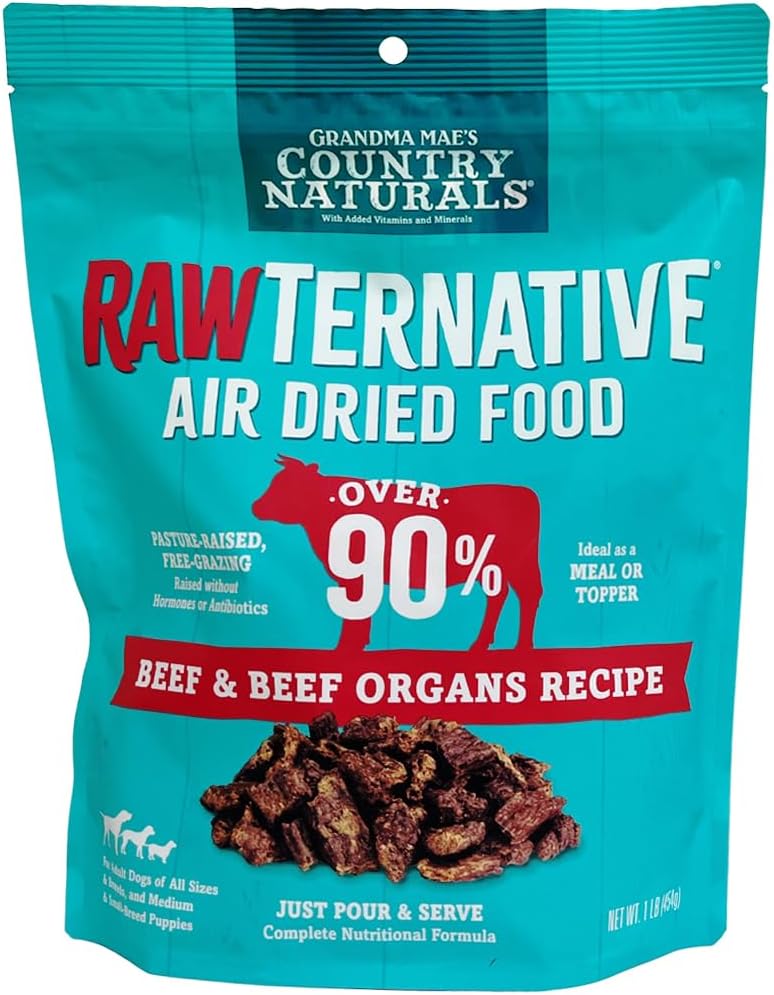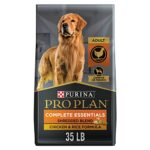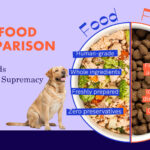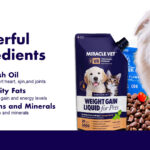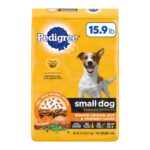Transitioning your pet to a new food requires a gradual mix-in approach. Start by blending the current and new diets together.
Introducing a new diet to your pet’s routine can be a delicate process. It’s essential to understand your furry friend’s dietary needs and how to adapt them to new nutritional offerings without causing digestive upset. A successful transition hinges on patience and attention to your pet’s acceptance of the new food.
This shift should not be rushed, as it can lead to rejection or health issues. Pet owners must strike a balance between the familiar and the unfamiliar, ensuring their companions remain comfortable and nourished throughout the change. This introduction sets the stage for a comprehensive guide on how to switch your pet’s food effectively and safely, promoting a healthy and happy transition for your cherished companion.
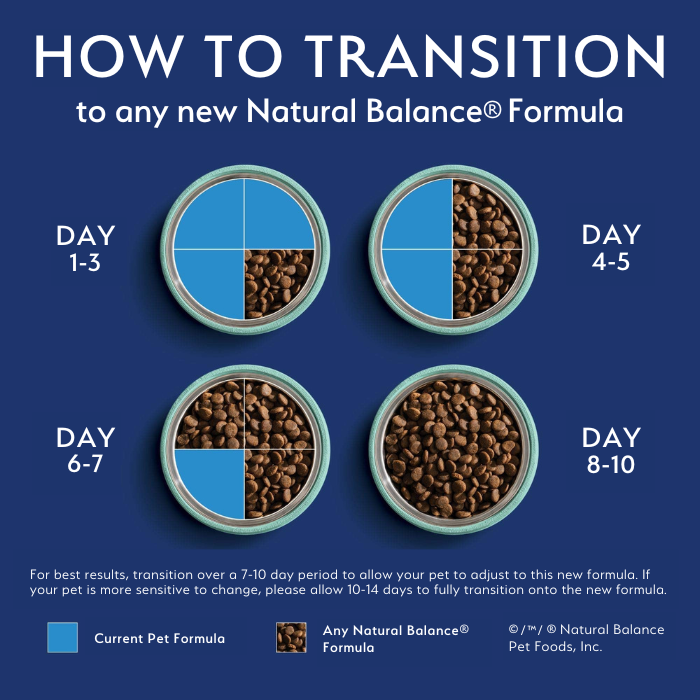
Credit: www.naturalbalanceinc.com
Introduction To Pet Dietary Changes
Changing your pet’s diet can seem daunting. It’s essential to understand why and how to do it safely. Pets, like humans, may need dietary adjustments for various reasons. A careful transition ensures your furry friend stays happy and healthy.
Reasons For Switching Pet Foods
Many factors influence the need to change a pet’s diet. These could include:
- Age-related needs: Puppies and kittens have different nutritional requirements than adult pets.
- Health issues: Conditions like allergies or diabetes may require specific food formulas.
- Quality improvements: Upgrading to a higher-quality food can boost overall health.
- Preference changes: Pets might get bored and stop eating their current food.
Potential Risks Of Abrupt Changes
Rapid dietary switches can lead to health problems. These risks include:
| Issue | Consequence |
|---|---|
| Upset Stomach | Vomiting or diarrhea |
| Food Rejection | Pets may refuse new food |
| Nutrient Imbalance | Can lead to health issues |
| Stress | Behavioral changes in pets |
Always transition your pet to new food gradually. This helps their system adjust without stress or discomfort. Seek advice from a vet for the best approach.
Signs Your Pet Needs A Diet Change
Just like humans, pets sometimes need a diet switch to stay healthy. Spotting when your furry friend requires a new menu is crucial. Look out for these clear signs.
Health Indicators
Pets often show physical signs when their current diet isn’t fitting anymore. Key indicators include:
- Dull coat or skin issues – A shiny coat fades or skin becomes itchy.
- Weight changes – Unexpected gain or loss signals trouble.
- Stomach upsets – Frequent diarrhea or vomiting can mean dietary intolerance.
Behavioral Cues
A change in behavior often suggests your pet’s diet may be lacking. Look for:
- Lack of energy – Your pet seems tired or less playful.
- Food disinterest – They leave food untouched or eat less.
- Agitation – They appear more irritable or restless.
Choosing The Right Food For Your Pet
Every pet owner wants the best for their furry friend. Selecting the right food is crucial for their health and happiness. Pets have diverse dietary needs. These depend on many factors. Your pet’s age, breed, and lifestyle all play a role. Let’s explore how to choose the best food for your pet.
Nutritional Considerations
Quality nutrition is the cornerstone of a healthy pet. Always check the food label. Look for high-quality protein sources. These should be listed first. Real meat, fish, or poultry are excellent choices. Ensure a balance of fats and carbohydrates. Pets need these for energy. Vitamins and minerals support overall health. They should be present in the right amounts. Avoid artificial colors and preservatives. These can harm your pet over time.
Key nutrients include:
- Protein – Builds muscle and repairs tissue
- Fats – Provides energy and supports skin health
- Carbohydrates – Offers energy and digestive fiber
- Vitamins and Minerals – Essential for immune function and metabolism
Age And Lifestyle Factors
Different life stages require different diets. Puppies and kittens need growth-focused food. It’s rich in calories and nutrients. Adult pets need balanced maintenance food. Seniors need fewer calories but more joint support. Active pets require more energy. They benefit from higher-calorie foods. Indoor pets may need weight management options. Keep these factors in mind:
| Life Stage | Food Type | Considerations |
|---|---|---|
| Puppy/Kitten | Growth | High in calories and nutrients |
| Adult | Maintenance | Well-balanced diet |
| Senior | Senior Formula | Supports joints, fewer calories |
| Active | High-Energy | More calories for energy |
| Indoor | Weight Management | Controls calorie intake |
The Role Of A Veterinarian In Diet Transition
Changing your pet’s diet can be tricky. A veterinarian plays a crucial role in this process. They ensure the transition is smooth and healthy.
Professional Dietary Advice
Consulting a veterinarian provides access to expert dietary advice. They tailor recommendations based on your pet’s age, health, and lifestyle. This personalized approach helps prevent dietary issues.
Health Assessments Pre-transition
Before starting a new diet, a thorough health check is essential. This checkup spots potential issues that might affect dietary choices. Here are key assessments:
- Weight check – Ensures the diet fits your pet’s weight goals.
- Allergy tests – Identifies any food sensitivities.
- Blood work – Reveals any underlying health conditions.
These steps confirm that the chosen food is perfect for your pet. They help avoid adverse reactions and health problems.
Always follow your vet’s guidance during food transitions. Their expertise is invaluable in keeping your pet healthy and happy.
Creating A Transition Plan
Switching your pet’s diet is not a snap decision. It requires a thought-out plan to ensure your furry friend’s stomach is at ease. A proper transition plan is critical to avoid digestive upset or food rejection.
Setting A Timeline
Time is key for a smooth food transition. Start with a 7 to 10-day period for the changeover. Pets need this time to adjust. A slow switch helps their system adapt without stress.
- Day 1-3: Mix 25% new food with 75% old food.
- Day 4-6: Even the mix to 50% new food, 50% old food.
- Day 7-9: Shift the balance to 75% new food, 25% old food.
- Day 10: Serve 100% new food.
Watch your pet’s reaction throughout the timeline. Adjust as needed. Some may need more time, others less.
Gradual Mixing Techniques
How you mix foods matters. A gentle blend is important for taste and digestion.
| Technique | Description | Benefit |
|---|---|---|
| Consistent Portions | Use a measuring cup for accuracy. | Ensures gradual increase of new food. |
| Thorough Mixing | Stir both foods together well. | Prevents selective eating. |
| Temperature Match | Keep both foods at room temp. | Enhances flavor and acceptance. |
Remember to keep fresh water available and monitor your pet’s appetite and stool. Changes in these can signal how well the transition is going.
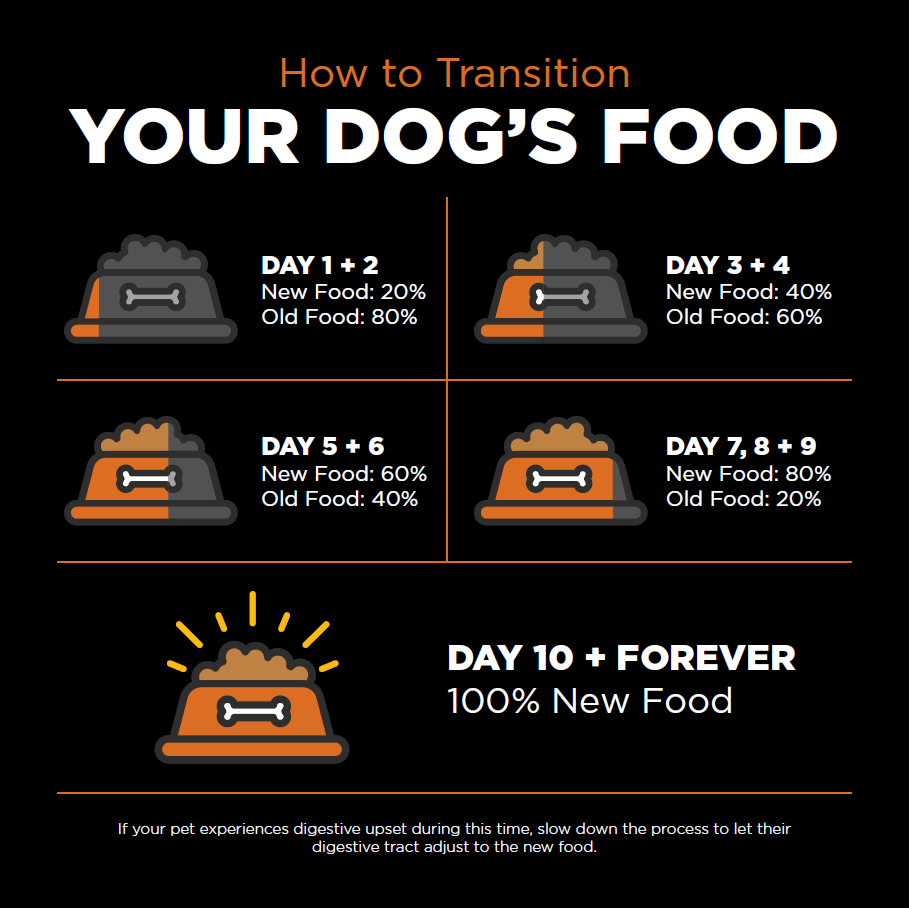
Credit: go-solutions.com
Understanding Food Labels And Ingredients
When you switch your pet’s diet, it’s crucial to understand food labels and ingredients. This knowledge ensures your furry friend gets the best nutrition. Let’s decode the information on pet food packages together.
Deciphering Nutritional Information
Reading nutritional labels helps you choose the right food for your pet’s health. Start with the ‘Guaranteed Analysis.’ This section shows protein, fat, fiber, and moisture content. These numbers tell you if the food meets your pet’s dietary needs. Aim for a balance that suits their age, size, and activity level.
Look for the AAFCO statement. It confirms the food provides complete nutrition. This statement means experts have checked the food for essential nutrients.
Identifying Quality Ingredients
The ingredient list on pet food tells you what’s inside. Ingredients are listed by weight. Those at the top weigh the most. They should be high-quality sources of protein like chicken, beef, or fish.
- Check for real meat as the first ingredient. It’s a sign of a protein-rich diet.
- Avoid by-products and fillers like corn and wheat gluten. They offer less nutrition.
- Seek out whole foods. Ingredients like whole grains and vegetables are healthy additions.
- Watch for artificial additives. Colors and preservatives can be harmful. Choose foods without these.
Understanding these labels makes a big difference. You can pick a food that keeps your pet healthy and happy. Now, let’s get your pet started on their new diet with confidence.
Monitoring Your Pet’s Reaction To New Food
Switching your pet’s food needs careful monitoring. Watch their reactions for a smooth transition.
Physical Changes To Look For
Keep an eye on your pet’s body during the food switch. Here are key signs:
- Coat quality: Look for changes in shine and shedding.
- Stool consistency: Notice if stools are too hard or too soft.
- Weight fluctuations: Track any sudden weight gain or loss.
- Energy levels: See if your pet seems more tired or hyperactive.
Behavioral Adjustments
Behavior can tell a lot about how your pet feels about the new food:
| Behavior | What It Might Mean |
|---|---|
| Increased thirst | Maybe more salt in the new food |
| Less interest in food | They might not like the taste |
| Chewing more or less | Texture could be different |
Always talk to a vet if you see odd behaviors or physical changes.
The Importance Of Consistency
The Importance of Consistency in transitioning your pet to a new food is crucial. Pets thrive on routine. Abrupt changes can lead to digestive issues. Ease the transition and maintain a steady schedule. This approach supports their health and well-being.
Feeding Schedules
Creating a consistent feeding schedule is key. Pets need to know when to expect their meals. This reduces stress and helps their body adjust to new food. Stick to the same times each day. Your pet will feel secure and comfortable with the routine.
Portion Control
Portion control plays an important role. Overfeeding can cause weight gain. Underfeeding may lead to nutritional deficiencies. Use a measuring cup for accuracy. Follow the guidelines on the food packaging. Adjust as needed based on your pet’s size, age, and activity level.
| Week | Old Food (%) | New Food (%) |
|---|---|---|
| 1 | 75 | 25 |
| 2 | 50 | 50 |
| 3 | 25 | 75 |
| 4 | 0 | 100 |
Use the above table as a transition guide. Mix old and new food. Increase the new food percentage weekly. Monitor your pet’s reaction closely. If issues arise, slow down the transition.
- Start with small portions of new food.
- Gradually increase the new food amount.
- Keep an eye on your pet’s health and appetite.
- Consult your vet before starting the transition.
- Choose a high-quality food that suits your pet’s needs.
- Be patient and give your pet time to adjust.
Handling Digestive Upset
Handling Digestive Upset is a critical part of transitioning your pet to a new food. A pet’s stomach may be sensitive to dietary changes. This can lead to discomfort. Observing your pet’s reaction during this period is vital. The right approach can ease their system into accepting new food.
Common Symptoms
Pets show several signs when they experience digestive upset. Look for these symptoms:
- Loose stools
- Vomiting
- Lethargy
- Gas
- Stomach gurgling
Spotting these early helps manage your pet’s comfort. Use gentle petting and a calm voice to soothe them.
When To Consult A Vet
Some symptoms suggest a vet visit is needed. These include:
- Continuous vomiting over two days
- Blood in vomit or stool
- Unexplained weight loss
- Dehydration signs, like dry gums
- Refusal to eat for over two days
A vet can offer tailored advice. They may suggest a slower transition or a different food type.

Credit: www.lotuspetfoods.com
Hydration And Diet Change
Hydration plays a crucial role in your pet’s health, especially when switching to a new diet. A change in food can affect their water consumption. Your pet may need more water to help digest different nutrients. Let’s ensure they stay hydrated during this transition.
Increasing Water Intake
When changing your pet’s diet, monitor their water intake. Here are some tips to encourage them:
- Provide fresh water at all times.
- Place multiple water bowls around your home.
- Consider a pet water fountain to spark interest.
- Mix wet food with dry kibble to add moisture.
These steps help maintain proper hydration.
Signs Of Dehydration
Dehydration in pets can be serious. Recognize these signs early:
| Sign | Description |
|---|---|
| Lethargy | Less active or playful. |
| Dry Gums | Gums feel sticky or dry. |
| Sunken Eyes | Eyes may look dull. |
| Loss of Appetite | Refuses food or eats less. |
If you notice these signs, contact a vet promptly.
Transitioning Between Dry And Wet Foods
Moving your pet from dry kibble to wet food can be a bit tricky. Pets get used to their regular food’s taste and texture. A sudden switch might upset their stomachs. It’s important to take it slow. Let’s explore how to make this transition smooth for your furry friend.
Differences In Texture And Taste
Dry and wet foods offer unique experiences for your pet. Dry food has a crunchy texture and requires more chewing. Wet food is softer and easier to eat. The taste of wet food is often richer. This can be more appealing to picky eaters. Pets might prefer one over the other. It’s crucial to observe your pet’s reaction during the transition.
- Dry food: Crunchy, less aromatic.
- Wet food: Soft, strong scent, richer flavor.
Adjusting Feeding Amounts
When changing food types, keep an eye on portion sizes. Wet food is typically more calorie-dense. This means you might need to feed less volume. Check the feeding guidelines on the food packaging. Use these as a starting point. Adjust as needed based on your pet’s activity level and weight.
| Food Type | Portion Size |
|---|---|
| Dry Food | Measured in cups |
| Wet Food | Measured in cans or grams |
Monitor your pet’s weight and appetite closely. It helps ensure they get the right amount of food. Pets can gain or lose weight quickly. Regular check-ins are vital during any diet change.
Special Considerations For Sensitive Pets
Special Considerations for Sensitive Pets require extra attention during dietary changes. Sensitive pets may react negatively to new foods. Their stomachs could become upset, or they might develop skin issues. To ensure the transition is smooth, pet owners should be aware of potential allergies and food intolerances. A careful approach can prevent adverse reactions.
Allergies And Food Intolerances
Identifying allergies and food intolerances is crucial. Common signs include itching, digestive distress, and lethargy. A vet can conduct tests to pinpoint the problem. Once known, select a suitable food. Look for products labeled ‘hypoallergenic’ or ‘limited ingredient’. These often work well for sensitive pets.
Gentler Transition Strategies
For a gentler transition, introduce the new food slowly. Start with a mix of 75% old food and 25% new food. Gradually change the proportions over ten days. This slow shift helps pets adjust without causing a shock to their system. Monitor your pet’s reaction daily. If issues arise, consult with a vet promptly.
- Day 1-3: 75% old food, 25% new food
- Day 4-6: 50% old food, 50% new food
- Day 7-9: 25% old food, 75% new food
- Day 10: 100% new food
Keep fresh water available at all times. A well-hydrated pet is more likely to have a smooth transition. Remember, patience and observation are key. Every pet is unique. What works for one might not work for another. Stay attentive and ready to adjust your approach if needed.
Involving The Whole Family
Switching your pet’s food is not just a task for one person. Everyone in the household plays a role. A family approach ensures a smooth transition for your furry friend.
Educating Family Members
It is vital to keep everyone on the same page. Explain why the new diet benefits your pet. Discuss the transition schedule and the importance of following it.
- Show the food labels to highlight the nutritional change.
- Use a feeding chart for clarity.
- Answer questions your family might have.
Maintaining Consistency With Multiple Caregivers
Pets thrive on routine. When different people are involved in feeding, consistency is key.
| Family Member | Responsibility |
|---|---|
| Mom | Morning feed |
| Dad | Evening feed |
| Kids | Weekend feed |
Ensure everyone uses the same measuring cup. Keep a feeding log to track your pet’s progress.
The Role Of Treats During Transition
Switching your pet’s food can be tricky. Treats play a big role in this process. They help your pet accept new food. But it’s important to use them wisely to keep your pet healthy.
Choosing Compatible Treats
When introducing new food, picking the right treats is crucial. Treats should match the new food’s ingredients. This helps your pet adjust without upsetting their stomach.
- Check labels for similar ingredients.
- Choose low-calorie treats to maintain a healthy diet.
- Avoid artificial colors and flavors, which can cause allergies.
Limiting Treats To Avoid Gastrointestinal Issues
Too many treats can lead to stomach problems. It’s important to limit them during food transition.
| Treat Type | Frequency |
|---|---|
| Soft Chews | Once a day |
| Crunchy Biscuits | Twice a week |
Keep treats to less than 10% of daily food intake.
Track how many treats you give. This helps prevent too many treats.
Conclusion: Embracing The New Diet
Transitioning your pet to a new food is an important step towards its well-being. Once you’ve introduced the new diet and monitored your pet’s adjustment, it’s time to embrace this change fully. Let’s celebrate their dietary milestones and ensure their long-term health.
Celebrating Milestones
Reaching a dietary milestone deserves recognition. Your pet’s successful switch to a new diet is a testament to your care and patience. Celebrate these moments with extra playtime or a healthy treat to reinforce positive change.
Maintaining Long-term Dietary Health
Keeping your pet healthy involves more than just a successful food transition. Regular vet check-ups and a balanced diet are key. Track your pet’s health, stay informed on nutritional needs, and be ready to adjust as they grow.
Frequently Asked Questions
How Long Does It Take For A Dog To Transition To New Food?
Transitioning a dog to new food typically takes about 5 to 7 days. Gradually mix the new food with the old, increasing the amount each day.
What Happens If You Just Switch Dog Food?
Switching your dog’s food suddenly can cause digestive upset, including diarrhea and vomiting. Gradually mix the new food with the old over several days to avoid these issues. This method helps your dog’s digestive system adjust smoothly.
How To Switch Dog Food Without Diarrhea?
Gradually mix new food with old over seven days, increasing new food amount daily. Monitor your dog’s response, ensuring fresh water is always available. If diarrhea occurs, slow the transition and consult a vet.
When Should I Change My Pet Food?
Change your pet’s food during life stage transitions, such as from puppy/kitten to adult or to senior. Also, switch if your vet recommends it due to health issues, if your pet develops food allergies, or if they stop enjoying their current food.
How Often Should I Switch Pet Foods?
Introduce new pet foods gradually over a week to prevent digestive upset, mixing increasing amounts of the new food with the old.
Conclusion
Switching your pet’s diet can be a smooth process with the right approach. Always introduce new food gradually and monitor their reaction. Remember, patience is key. Consult your vet for personalized advice to ensure a healthy transition. Your pet’s wellbeing is worth the extra effort!

